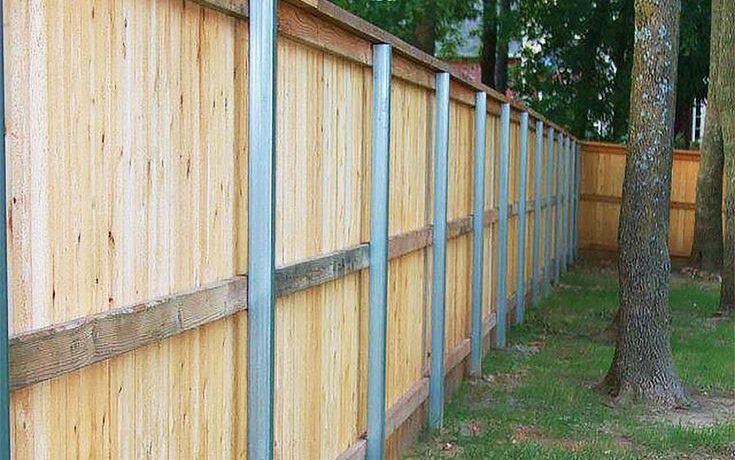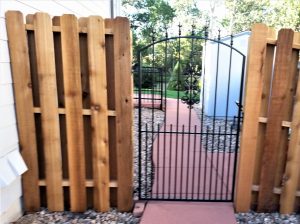All Categories
Featured
As sustainability comes to be a significantly crucial consider home and commercial building style, the need for environment-friendly products continues to climb. This includes materials for exterior rooms, particularly for fencings. While conventional fence choices like vinyl, timber, and metal can have considerable ecological downsides, there are numerous sustainable and green options offered. Picking eco responsible fence products helps reduce your carbon impact and sustains conservation initiatives. Allow's check out several of the most effective environmentally friendly fencing choices that advertise sustainability while likewise offering sturdiness and style.
Advantages: Bamboo calls for marginal water, pesticides, and fertilizers to expand. It is eco-friendly, lowering waste at the end of its life process. It is also resilient and immune to rot, making certain durability with correct care. Considerations: Bamboo might not be excellent for locations with severe winter seasons or severe cold, as it can become fragile and split in freezing temperatures. 2. Recycled Products Secure Fencing. Fencings made from recycled products, such as post-consumer plastics, reclaimed timber, or recycled steel, are coming to be significantly prominent in eco-conscious styles. These products lower waste, preserve sources, and minimize the need for the removal of basic materials, which is beneficial for the atmosphere. By repurposing existing materials, you add to decreasing the need for new, energy-intensive manufacturing processes.
Conveniences: Making use of recycled products helps divert waste from land fills, decreases environmental effect, and can reduce your carbon footprint. It is additionally an economical service sometimes. Considerations: The aesthetic of recycled product fencings can vary, and some may not accomplish the same all-natural look as conventional timber fences. However, lots of manufacturers now supply designs that reproduce the look of timber or stone. 3. Compound Secure fencing. Composite secure fencing is made from a blend of timber fibers and plastic, commonly sourced from recycled content. This kind of secure fencing uses the look of timber with minimal maintenance, while additionally being eco friendly. Composite materials are typically resilient and immune to the components, decreasing the demand for regular replacement or therapy with chemicals.
![]()
Conveniences: Compound fencings are sturdy, low-maintenance, and can be made from recycled content, aiding lower waste. They do not call for harmful chemicals for conservation, unlike treated timber. Factors to consider: While composite secure fencing is long lasting, it often tends to be more costly upfront compared to standard wood. However, its durability and low upkeep may make it a much more cost-efficient alternative with time. 4. Cedar and Redwood Fencing. Cedar and redwood are popular selections for environmentally-conscious fencing, as both materials are naturally resilient, resistant to decay, and call for very little chemical therapies. These woods can be sustainably harvested from properly handled woodlands, ensuring their environmentally friendly status. They additionally have an all-natural charm that several home owners value, with rich shades and textures that boost aesthetic appeal.
Benefits: Cedar and redwood fencings are long-lasting, normally pest-resistant, and have a low environmental impact when gathered sustainably. They also have an ageless aesthetic and can blend effortlessly right into natural landscapes. Considerations: While cedar and redwood are more green than other kinds of timber, they are still wood products and require correct upkeep to stop decay. The price might likewise be greater compared to various other products. 5. Living Fencings (Hedges and Hedges) For those looking for a more eco-friendly and natural choice, living fencings, or hedgerows, are a superb selection. Popular choices for living fences consist of boxwood, bamboo, and privet.
Advantages: Living fences boost air quality, add to biodiversity, and supply a natural appearance that blends perfectly with the landscape. They also lower environmental pollution and assist regulate temperature levels in your lawn. Factors to consider: Living fencings require normal upkeep, such as pruning and watering, and might not be suitable for every single environment. They likewise require time to establish prior to they can provide full privacy. 6. Stone and Brick Fencing (Reclaimed) Stone and block are incredibly long lasting materials, and utilizing redeemed rock or block can be an environment-friendly means to construct a fence. By recycling these products from old buildings or frameworks, you reduce the demand for brand-new sources and reduce waste. Rock and block fencings are strong, call for little maintenance, and supply a timeless seek to any kind of building.
![]()
Conveniences: Reclaimed stone and brick fencings are extremely long-lasting, low-maintenance, and supply superb personal privacy and protection. They are also energy-efficient, as they aid control temperature by acting as natural insulators. Factors to consider: Setup of stone and brick fences can be extra costly and labor-intensive than various other materials. In addition, these fencings may not appropriate for all residential or commercial properties as a result of the weight and the requirement for appropriate setup. Verdict. Green secure fencing alternatives are commonly offered and can be tailored to suit the visual and useful needs of your residential or commercial property. Bamboo, recycled products, composite fencing, and cedar or redwood all offer sustainable options to conventional products. Living fencings and recovered stone or block supply additional eco-conscious choices that additionally help improve your outdoor area. By choosing one of these sustainable fence products, you're making a favorable effect on the environment while producing a gorgeous and practical outside area. Whether you're concentrated on lowering your carbon impact or supporting biodiversity, there's a range of environment-friendly alternatives to take into consideration.
- Bamboo Fencing. Bamboo is one of the most green materials readily available for fencing. Bamboo fencings are strong, normally resistant to insects, and give a beautiful, natural aesthetic.
Advantages: Bamboo calls for marginal water, pesticides, and fertilizers to expand. It is eco-friendly, lowering waste at the end of its life process. It is also resilient and immune to rot, making certain durability with correct care. Considerations: Bamboo might not be excellent for locations with severe winter seasons or severe cold, as it can become fragile and split in freezing temperatures. 2. Recycled Products Secure Fencing. Fencings made from recycled products, such as post-consumer plastics, reclaimed timber, or recycled steel, are coming to be significantly prominent in eco-conscious styles. These products lower waste, preserve sources, and minimize the need for the removal of basic materials, which is beneficial for the atmosphere. By repurposing existing materials, you add to decreasing the need for new, energy-intensive manufacturing processes.
Conveniences: Making use of recycled products helps divert waste from land fills, decreases environmental effect, and can reduce your carbon footprint. It is additionally an economical service sometimes. Considerations: The aesthetic of recycled product fencings can vary, and some may not accomplish the same all-natural look as conventional timber fences. However, lots of manufacturers now supply designs that reproduce the look of timber or stone. 3. Compound Secure fencing. Composite secure fencing is made from a blend of timber fibers and plastic, commonly sourced from recycled content. This kind of secure fencing uses the look of timber with minimal maintenance, while additionally being eco friendly. Composite materials are typically resilient and immune to the components, decreasing the demand for regular replacement or therapy with chemicals.

Conveniences: Compound fencings are sturdy, low-maintenance, and can be made from recycled content, aiding lower waste. They do not call for harmful chemicals for conservation, unlike treated timber. Factors to consider: While composite secure fencing is long lasting, it often tends to be more costly upfront compared to standard wood. However, its durability and low upkeep may make it a much more cost-efficient alternative with time. 4. Cedar and Redwood Fencing. Cedar and redwood are popular selections for environmentally-conscious fencing, as both materials are naturally resilient, resistant to decay, and call for very little chemical therapies. These woods can be sustainably harvested from properly handled woodlands, ensuring their environmentally friendly status. They additionally have an all-natural charm that several home owners value, with rich shades and textures that boost aesthetic appeal.
Benefits: Cedar and redwood fencings are long-lasting, normally pest-resistant, and have a low environmental impact when gathered sustainably. They also have an ageless aesthetic and can blend effortlessly right into natural landscapes. Considerations: While cedar and redwood are more green than other kinds of timber, they are still wood products and require correct upkeep to stop decay. The price might likewise be greater compared to various other products. 5. Living Fencings (Hedges and Hedges) For those looking for a more eco-friendly and natural choice, living fencings, or hedgerows, are a superb selection. Popular choices for living fences consist of boxwood, bamboo, and privet.
Advantages: Living fences boost air quality, add to biodiversity, and supply a natural appearance that blends perfectly with the landscape. They also lower environmental pollution and assist regulate temperature levels in your lawn. Factors to consider: Living fencings require normal upkeep, such as pruning and watering, and might not be suitable for every single environment. They likewise require time to establish prior to they can provide full privacy. 6. Stone and Brick Fencing (Reclaimed) Stone and block are incredibly long lasting materials, and utilizing redeemed rock or block can be an environment-friendly means to construct a fence. By recycling these products from old buildings or frameworks, you reduce the demand for brand-new sources and reduce waste. Rock and block fencings are strong, call for little maintenance, and supply a timeless seek to any kind of building.

Conveniences: Reclaimed stone and brick fencings are extremely long-lasting, low-maintenance, and supply superb personal privacy and protection. They are also energy-efficient, as they aid control temperature by acting as natural insulators. Factors to consider: Setup of stone and brick fences can be extra costly and labor-intensive than various other materials. In addition, these fencings may not appropriate for all residential or commercial properties as a result of the weight and the requirement for appropriate setup. Verdict. Green secure fencing alternatives are commonly offered and can be tailored to suit the visual and useful needs of your residential or commercial property. Bamboo, recycled products, composite fencing, and cedar or redwood all offer sustainable options to conventional products. Living fencings and recovered stone or block supply additional eco-conscious choices that additionally help improve your outdoor area. By choosing one of these sustainable fence products, you're making a favorable effect on the environment while producing a gorgeous and practical outside area. Whether you're concentrated on lowering your carbon impact or supporting biodiversity, there's a range of environment-friendly alternatives to take into consideration.
Latest Posts
Recognizing When Your Car Needs Skilled Auto Repair at Montclare Auto Repair
Published May 24, 25
1 min read
Learn About Exceptional Auto Repair Services in Chicago – Expert Care for Your Vehicle
Published May 23, 25
1 min read
Boost Your Home's Exterior with Weathercraft's Exterior siding Solutions
Published May 22, 25
1 min read
More
Latest Posts
Recognizing When Your Car Needs Skilled Auto Repair at Montclare Auto Repair
Published May 24, 25
1 min read
Learn About Exceptional Auto Repair Services in Chicago – Expert Care for Your Vehicle
Published May 23, 25
1 min read
Boost Your Home's Exterior with Weathercraft's Exterior siding Solutions
Published May 22, 25
1 min read